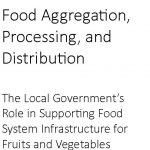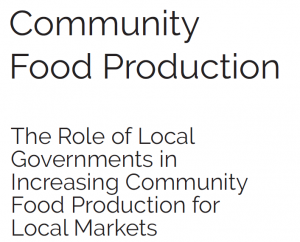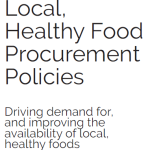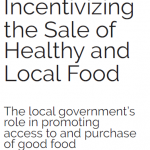The Growing Food Connections Planning and Policy Brief Series highlights promising planning and policy strategies used by local governments across North America to promote agricultural viability and/or healthy food access. Drawing heavily from the Communities of Innovation research, each brief delves into one specific food systems planning or policy issue, explains the significance of the issue and how the issue is connected to other social, economic, and ecological issues within a community, and offers 3 to 5 innovative, planning and policy examples to address the issue. This series will explore a range of food systems issues such as incentivizing access to healthy food, developing local food procurement policies, financing food infrastructure, planning for the food system, and much more. Local government staff, elected and appointed officials, and non-governmental organizations alike will find this series helpful in their efforts to strengthen their community’s food system. New briefs will be added on a regular basis.Many local governments are realizing the importance of local and regional food systems in advancing economic, social, and community health goals.
 The steps of Food Aggregation, Processing, and Distribution all have policy, regulatory, programmatic, and funding implications. These steps are vital in diversifying and growing the ways that small and mid-sized farmers and food businesses can reach consumers, filling gaps in the current food distribution system to meet demand for local, sustainably produced products and better allowing local producers to meet the rapidly changing demands of local food markets. Strengthening food distribution networks maximizes the ways in which local and regional food systems can help meet important economic, health, and community goals.
The steps of Food Aggregation, Processing, and Distribution all have policy, regulatory, programmatic, and funding implications. These steps are vital in diversifying and growing the ways that small and mid-sized farmers and food businesses can reach consumers, filling gaps in the current food distribution system to meet demand for local, sustainably produced products and better allowing local producers to meet the rapidly changing demands of local food markets. Strengthening food distribution networks maximizes the ways in which local and regional food systems can help meet important economic, health, and community goals.
Local, Healthy Food Procurement Policies are policies adopted by local governments that affect what type of food is being purchased, provided, or made available by public agencies. They can be useful tools in promoting both local agricultural viability as well as the availability of healthy food. By adopting a food procurement policy that makes a strong statement for both local and healthy food, a local government can support local food systems, help augment demand for locally produced and healthy food, and help improve the availability of healthy foods.
Across the country, local governments are developing and implementing a wide range of policies, programs, and projects to support Incentivizing the Sale of Healthy and Local Food for their residents. Community members, especially low-income residents and people of color, may face multiple barriers to accessing and purchasing healthy food, from a lack of healthy food retail outlets in their neighborhoods to affordability challenges for fresh foods. Local governments can take action to help overcome these access and economic barriers.
 This planning and policy brief provides an overview of the barriers and constraints to Community Food Production for local markets, and the various local government strategies that can be used to ensure that regulatory, economic, and policy climates support and promote food production; create more “farm friendly” environments; and grow the next generation of farmers. Increasing the production of food for local markets, both to meet market demand and to provide the attendant community benefits, should be a key consideration in local governments’ food systems development efforts.
This planning and policy brief provides an overview of the barriers and constraints to Community Food Production for local markets, and the various local government strategies that can be used to ensure that regulatory, economic, and policy climates support and promote food production; create more “farm friendly” environments; and grow the next generation of farmers. Increasing the production of food for local markets, both to meet market demand and to provide the attendant community benefits, should be a key consideration in local governments’ food systems development efforts.
 Over the past several decades, many local governments have recognized the threats to their important agricultural lands and have taken steps to protect them. Planners and officials must continue to recognize farmland as a vital local resource in planning and policy documents and develop goals and actions to preserve it. Farmland Protection provides an overview of a range of regulatory and programmatic approaches that can be used to protect farmland from nonfarm development.
Over the past several decades, many local governments have recognized the threats to their important agricultural lands and have taken steps to protect them. Planners and officials must continue to recognize farmland as a vital local resource in planning and policy documents and develop goals and actions to preserve it. Farmland Protection provides an overview of a range of regulatory and programmatic approaches that can be used to protect farmland from nonfarm development.
 Community food systems offer important economic development opportunities for communities. Investing in local and regional food economies can support local businesses, create jobs, and circulate money within the local economy. For community food systems to emerge as a viable part of economic development strategies, planners and local governments must make its case to the economic development community and better integrate food systems into economic development strategies. Increasingly, economic development strategies are being integrated with community development principles that focus on using local resources to build wealth and improve social conditions throughout the community. Doing so brings a greater emphasis to creating new local businesses, retaining and expanding existing businesses, and serving local needs. Community Food Systems and Economic Development describes a wide range of both direct and indirect strategies and actions that local governments have taken in their efforts to support local farmers and food businesses.
Community food systems offer important economic development opportunities for communities. Investing in local and regional food economies can support local businesses, create jobs, and circulate money within the local economy. For community food systems to emerge as a viable part of economic development strategies, planners and local governments must make its case to the economic development community and better integrate food systems into economic development strategies. Increasingly, economic development strategies are being integrated with community development principles that focus on using local resources to build wealth and improve social conditions throughout the community. Doing so brings a greater emphasis to creating new local businesses, retaining and expanding existing businesses, and serving local needs. Community Food Systems and Economic Development describes a wide range of both direct and indirect strategies and actions that local governments have taken in their efforts to support local farmers and food businesses.


